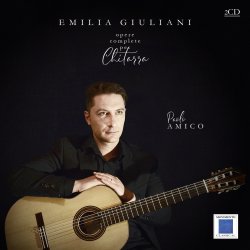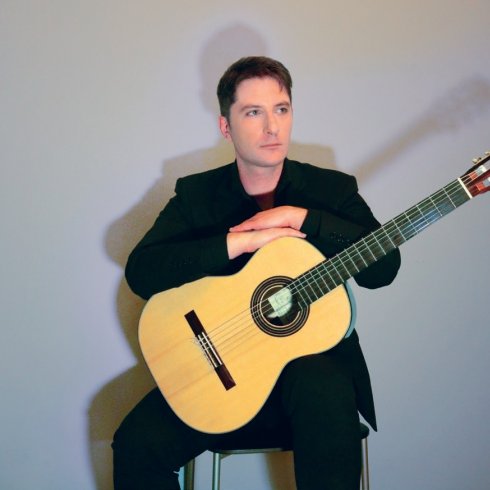

Opere complete per chitarra
Emilia Giuliani was born in Vienna in 1813 on 6th February 1828 officially debuted at Teatro Nuovo in Naples, playing at a concert with her father Mauro. It could have been a start to a new concert career, following the revival of her father’s, but Emilia’s first concert was also her father’s last – Mauro Giuliani died on 7th May 1829 and Emilia, still under age, was entrusted to her aunt Emanuela, her father’s sister. Until then, any news about Emilia had always been linked to her important father figure, but after Mauro’s death it was hard to keep track of a very young concert player at her debut, a virtuoso of an instrument which was not in its golden age anymore and – what was even more – a woman. Nicoletta Confalone’s painstaking detailed research, alongside that of Robert Coldwell and Grégory Leclair is therefore very valuable. Though we have very scarce news thereof, it is clear that Emilia must have had a certain success if between 1834 and 1836 the editor Giovanni Ricordi bought and published all her works (but one, which we are going to deal with later on) – Paolo Amico’s recording comprises Emilia Giuliani’s com- plete works. It is a very well defined repertoire, with variations on famous opera pieces. Emilia’s choices were very precise: except for the variations on the theme Non più mesta accanto al fuoco from Cenerentola by Gio- achino Rossini and the Variariazioni on a theme by Saverio Mercadante, the composer’s attention focused almost exclusively on Vincenzo Bellini. The collection called Belliniana is worthy of note: it is divided into six dif- ferent instalments, which were sold separately, as it had been customary in the early nineteenth-century (and it still was until most recently…) – Mauro Giuliani had published a collection called Rossiniane in his time, thus it is clear that Emilia had her father in mind for her publishing debut. The choice of this author provides food for thought. Up to the 1830s Rossini, Bellini and Mercadante’s success had set the theatrical trend of the time and the repertoire of reductions and variations of famous ope- ra pieces had thrived on the theatrical success of the original works. In 1834-1836 Rossini started composing less, Bellini was dead and Merca- dante had already decided to devote himself to the more secure job of chapel master at Novara cathedral (although he still went on composing music): Emilia Giuliani’s choice of pieces may seem a little vintage, but that isn’t so. The long process that would lead to the formation of the ca- non of repertoire pieces had started developing just then: modern new works (Donizetti was still composing and a certain Giuseppe Fortunio Verdi from Busseto was just about to start) were represented alongside those from the past, which were still popular hits in the publishing market. The publication of Emilia Giuliani’s works is extremely helpful to us – news about her upcoming concert career, as well as those about her previous achievements, are indeed essential. We know the dates and places of her exhibitions, but little do we know about the pieces she played. As she was a composer who played her own pieces, it is quite obvious she mostly played her own works during her exhibitions. Her concert career seems to have enjoyed a revival in Florence and Rome from 1839, but why did almost three years go by between the publication of her works and her comeback? That lapse of time is obviously obscure due to a lack of sources, and in the future we might find new evidence of concerts Emilia gave during those three years – but we could maybe take into account some more perso- nal, family reasons. In 1835 Emilia was in Naples, where she was living in Vico Lungo Avvocatura n.52, and that was when she had her first child, Giovan Battista Mauro Carlo, from Luigi Guglielmi, singer and nephew of the more famous Pietro Alessandro and Pietro should we imagine her new role as a mother slowed or even stopped Emilia’s concert career? That is for sure, but such a long silence makes me believe news of some concerts at that time will sooner or later appear. I was talking about an emancipated, even unconventional woman a little while ago – Emilia was unconventional in her private life, too, as in some ways her father had been before her: she became a mother, not a wife – or, rather, she would only marry Luigi Guglielmi in 1839 after their second child, Gaetano, was born. The two-year period between 1839 and 1840 was the most intense in Emi- lia’s concert life. She had four concerts with the harpist Marianna Creti De Rocchis at the Philharmonic Academy in Rome, but it was in Florence that Emilia notched up her most significant success. In the Tuscan capital Emilia Giuliani and her husband stroke up a friendship with the Polish prince Stani- slaw Poniatowski, who was the manager of Standisch Theatre – where Giu- lia would perform alongside Franz Liszt on 25th June 1839. Florence was not only the occasion for meeting the famous Hungarian virtuoso, it was also the starting point for a significant turn in Emilia and her husband’s career: it was right in Florence that they planned to move with their family to Vienna. For Emilia Giuliani this meant not only coming back to her hometown, but especially following in her father’s footsteps, too. Emilia and Luigi got to Vienna in October, 1840. As previously noted, they did not move to Vienna by chance – they were following a plan: on 8th December 1840 Emilia had her first Viennese concert at the Gesellschaft der Musikfreunde, the press covered Mauro Giuliani’s daughter’s performance and there is evidence Emilia played both pieces by her father and a piece for guitar and orchestra. On 3rd January 1841 the Viennese press announced Ar- taria publishing house had issued Six preludes for guitar by Emilia Giu- liani. A concert at one of the most important halls in town, a wide media coverage in the local press and the publication of a new collection by the leading Viennese publishing house – all these details show us how Emilia had left nothing to chance when planning to move to the Empire capital. Besides, the Six preludes had very different features from the pre- vious music published in Milan: they did not belong to the melodrama anymore, they were part of an openly instrumental tradition, that had little in common with arias and opera – somebody has tried drawing a parallel between her preludes and the piano preludes by Chopin, but I think that comparison may be too far-fetched, though this does not di- minish the musical value of Emilia’s very refined compositions, whe- reof the sixth and last prelude has rightly gained quite a certain fame. Emilia Giuliani proved she knew what she was heading for, namely an audience with very different musical taste to that of Italy, and the fact that she had to stand comparison with the memory of her father Mauro that is why she appeared in front of the Viennese audience with two very precise credentials, a new kind of repertoire and that virtuoso di- splay which had been such an important key to her father’s success. Things did not go according to Emilia’s careful and ingenious plan, thou- gh: times were changing and a series of coincidences got things straight immediately. After the December concert Emilia was widely praised by the press, but her guitar repertoire was not – the end of the golden age of ni- neteenth-century guitar playing was approaching and the models for guitar concerts were radically changing. Two days before Emilia’s performance, the guitar player Guido Regondi had had his Viennese debut, and he would have many other shows in town during the first months of 1841. Regondi’s style was very espressivo, much closer to romantic sensitivity, and it fled from virtuoso display per se – his success confined Emilia to the group of virtuosos who were considered “aggressive musicians” and “charlatans of feeling”, thus nipping the success of her Viennese concert right in the bud. A new phase opened up in Emilia Giuliani’s artistic career. Emilia and her husband made friends with count Johann Nàko, who then became their patron. Between 1845 and 1846 they followed the noble Hungarian to Pest and took up their residence in the town of Nagykomlòs, where the Nàkos had their castle. The count had started an innovative cultural project: he had his own theatre and he directly involved the whole villa- ge in the cultural life of his province court. Thanks to his experience in melodrama, Luigi Guglielmi probably supervised over the life of this small theatre, where regular singers from Teatro alla Scala and Teatro San Car- lo also performed, and where probably Emilia herself performed as well. But fate did not stop hounding Emilia and her husband: count Nakò suddenly died in 1848, which was a very significant year in European history and which would lead to some unpleasant consequences for mu- sicians (as Wagner taught us). Luigi Guglielmi tried to go back to Italy and work as melodrama author, but Giuseppe Verdi’s rising star thwar- ted his attempt. Emilia continued her concert career: on 17th April 1847 she performed at the Redoutensaale in Pest, while her last known con- cert took place at the Sommertheater in Buda on 25th September 1849. That was her last attempt at starting a new artistic phase. A never-ending, stubborn attempt at a new start had marked Emilia Giuliani’s entire life, indeed: she had tried to overcome her father figure, she had looked for success in publishing, she had renewed her repertoire, she had taken part in a cultural and philanthropic project which was maybe too visionary she had often found herself in the right place at the wrong moment in time, though, and she had never been favoured by historic coincidences. She died in Pest on 25th November 1850. Today we can finally pay tribu- te to the remarkable music of this brave and unconventional woman and guitar player.


Paolo Amico
Guitar player, was born in Varese in 1983. He started studying music at the age of six. In 1994 he was admitted to Civico Liceo Musicale “Riccardo Malipiero” in Varese, where he studied guitar with Maestro Giacomo Maruzzelli. In 2005 Paolo got his full marks diploma at “G. Cantelli” Conservatoire in Novara and then he took courses and masterclasses with various artists, mainly specializing with
Emanuele Segre and Giulio Tampalini. Paolo made his debut in 1998 and he has been performing in different theatres and concert halls all over Italy ever since. He plays both solo and with chamber orchestras. He teaches guitar at Civico Liceo Musicale “Riccardo Malipiero” in Varese, leading his students to brilliant results at their conservatoire exams. He has a BA from Università degli Studi in Milano. He plays a guitar especially built for him by the guitar maker Fabio Schmidt.
